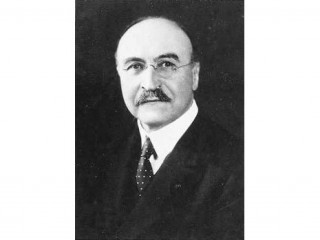
Leo Hendrik Baekeland biography
Date of birth : 1863-11-14
Date of death : 1944-02-23
Birthplace : Sint-Martens-Latem, Belgium
Nationality : Belgian
Category : Arhitecture and Engineering
Last modified : 2011-10-13
Credited as : chemist, inventor Bakelite, manufacturer
An American chemist, inventor, and manufacturer, Leo Hendrik Baekeland invented Bakelite, the first plastic to be used widely in industry.
Leo Ernst Baekeland was born in 1863 in Ghent, Belgium. He took a bachelor of science degree from the University of Ghent in 1882 and began to teach there as an assistant professor; he received his doctorate in natural science in 1884 and continued to teach for another 5 years. In 1889 he went to the United States on a traveling scholarship, liked the country, received a job offer from a photographic firm, and decided to make America his home.
These were the years when science was first coming to the attention of American industry. In some European countries, notably Germany, industrial research was already helping to improve old products and processes and to develop new ones. This wedding of science and technology was just beginning in the United States, first in those industries that had been close to science from their beginnings, such as the chemical and electrical industries. The manufacture of photographic equipment and materials was one such industry. Baekeland began work to improve photographic film, and in 1893 he established the Nepera Chemical Company to manufacture Velox paper, a film of his invention which could be handled in the light. In 1899 he sold out to the leading firm in the field, Eastman Kodak, and used the money to set up his own private industrial research laboratory in a converted barn behind his home in Yonkers, N.Y.
At this laboratory Baekeland began a large number of experiments covering a range of subjects. One of these was an attempt to produce a synthetic shellac by mixing formal-dehyde and phenolic bodies. Other experimenters had worked with these two substances, and it was known that the interaction was greatly influenced by the proportions used and the conditions under which they were brought together. Baekeland failed to synthesize shellac but instead discovered Bakelite, the first successful plastic.
Earlier plastics had only limited usefulness because of their tendency to soften when heated, harden when cooled, and interact readily with many chemical substances. Baekeland's new material did not suffer from any of these defects. Using temperatures much higher than previously thought possible, he developed a process for placing the material in a hot mold and adding both pressure and more heat so that a chemical change would take place, transforming the material in composition as well as shape.
He patented this process in 1909 and formed the Bakelite Corporation the following year to market the material. Bakelite soon became very successful and was widely used in industry as a substitute for hard rubber and amber, particularly in electrical devices. He retired from the company in 1939, honored for his success as a manufacturer and for his effectiveness as a spokesman for the whole concept of scientific research in the aid of industry.
















